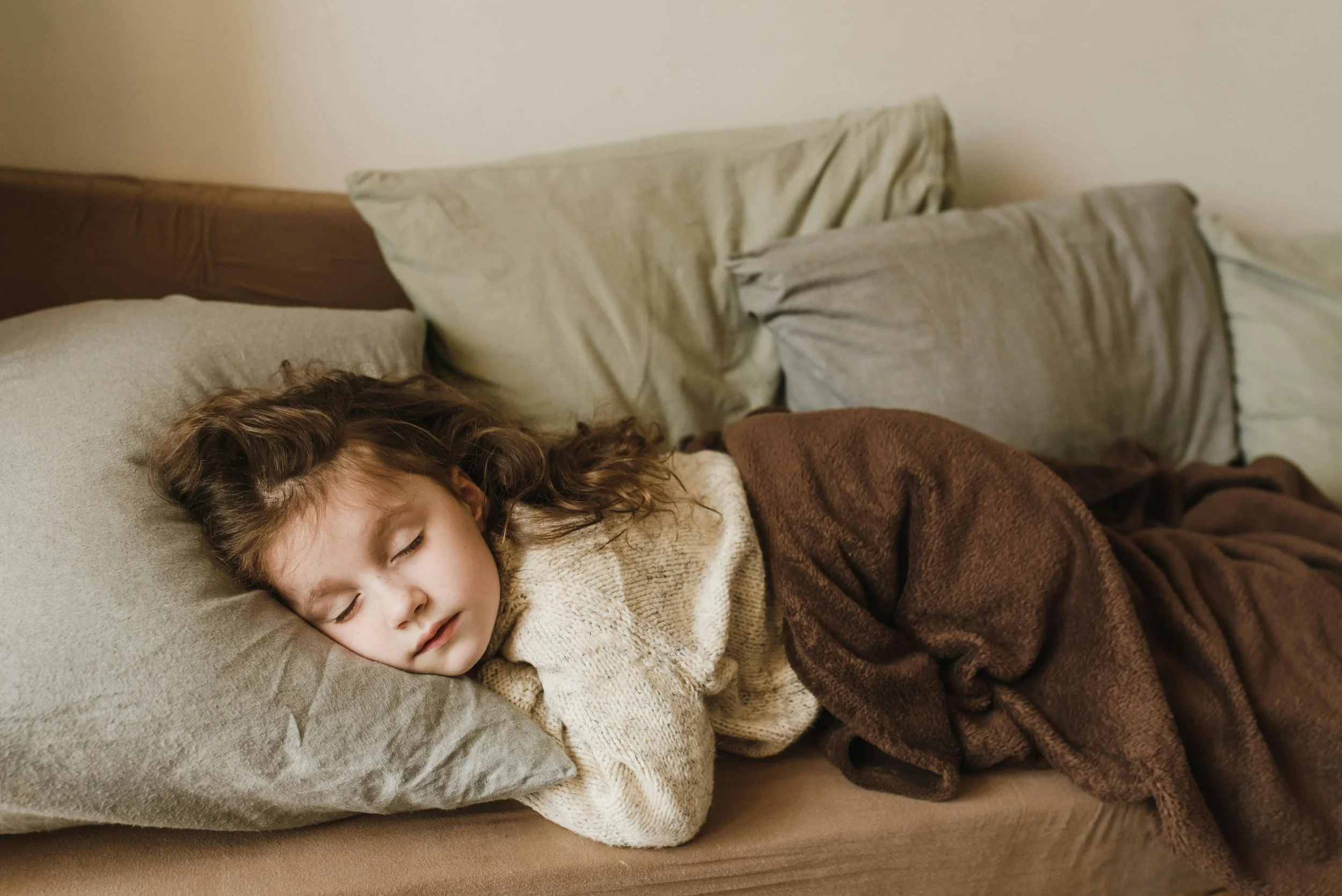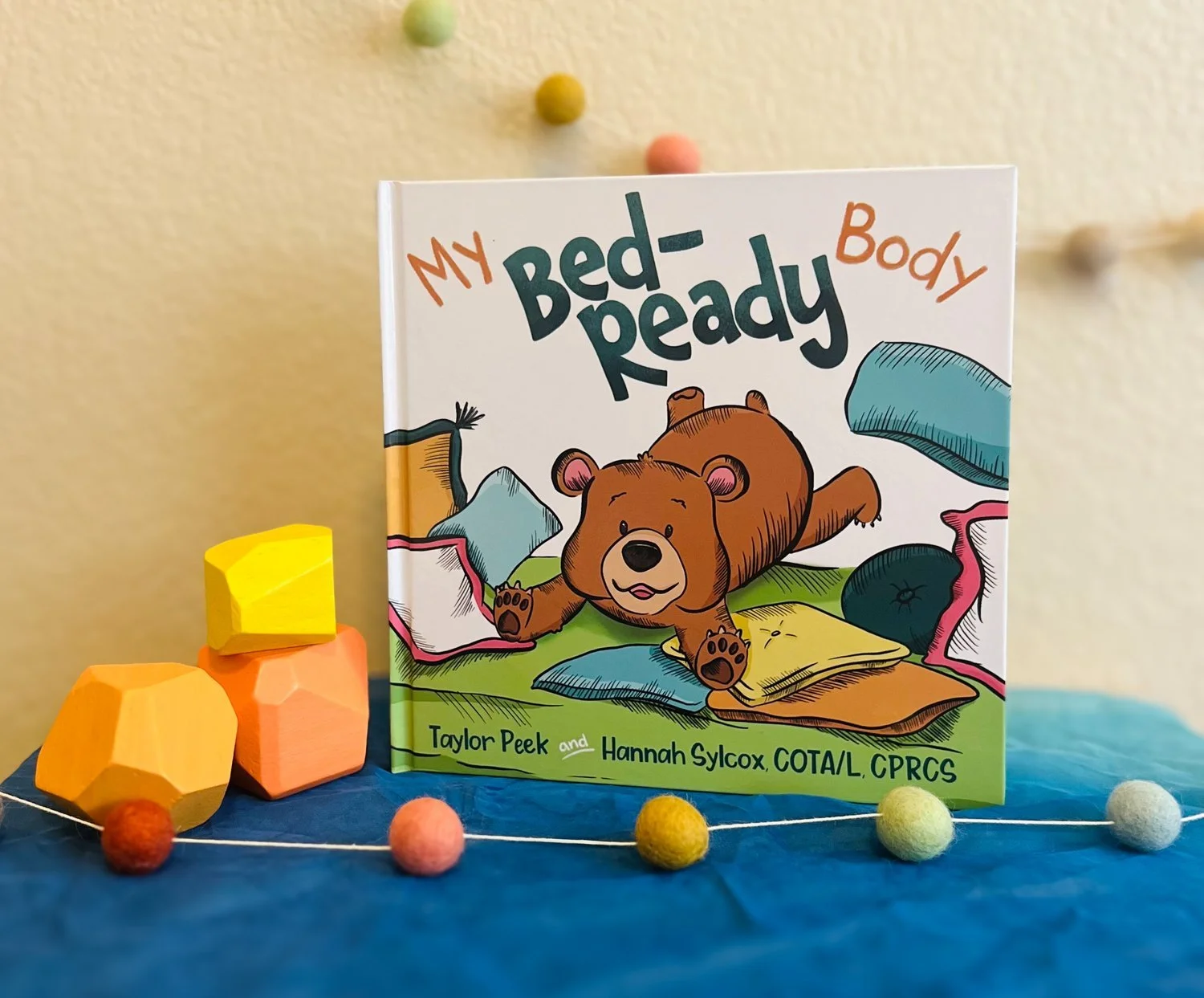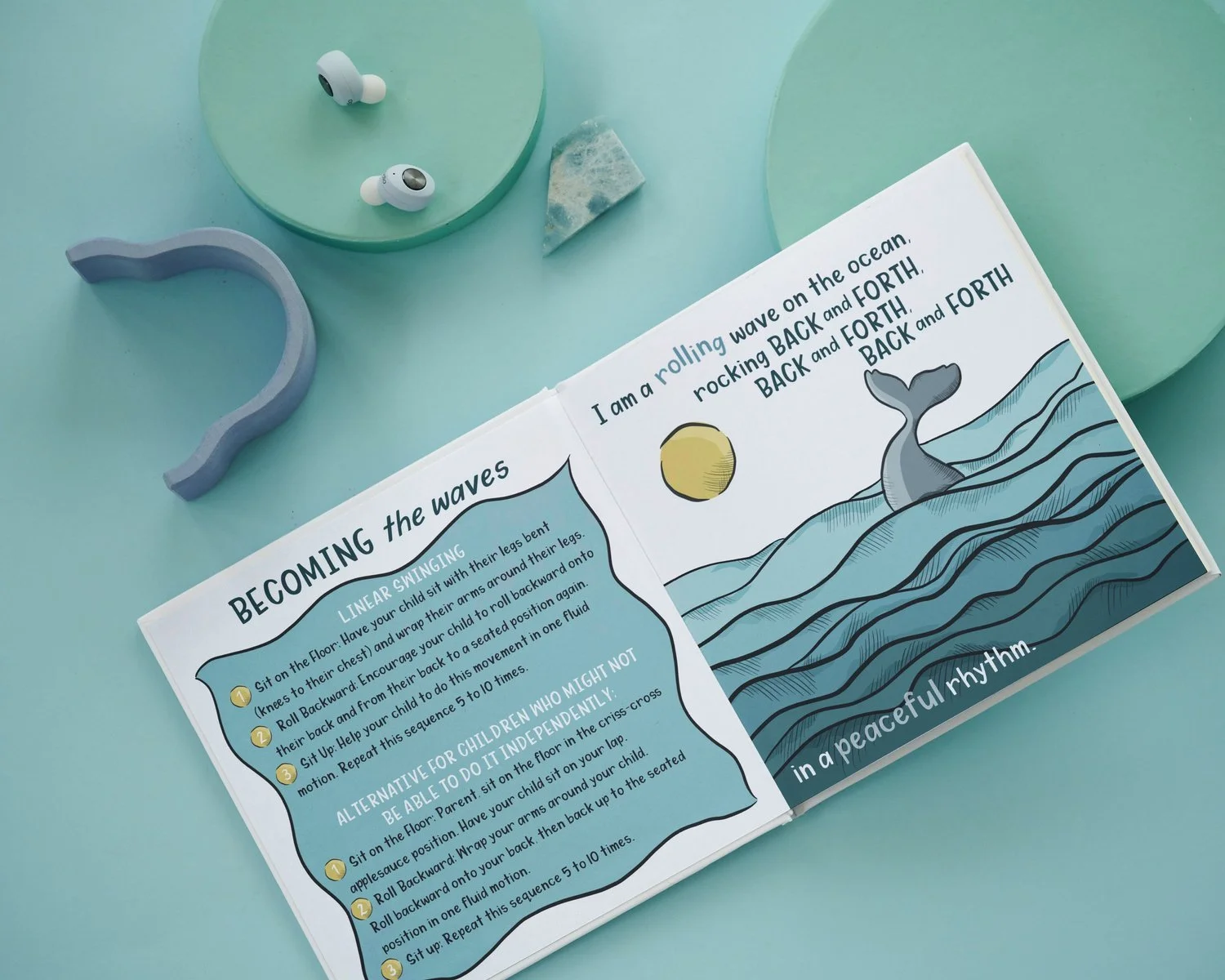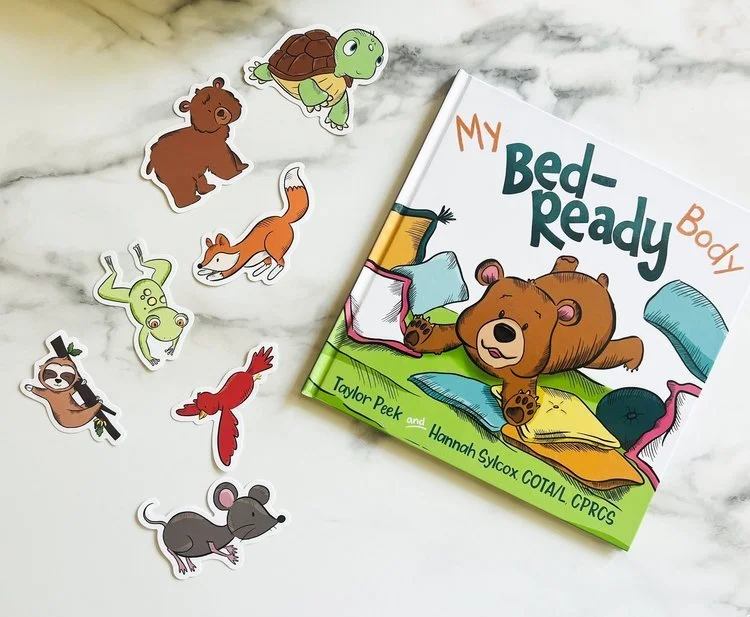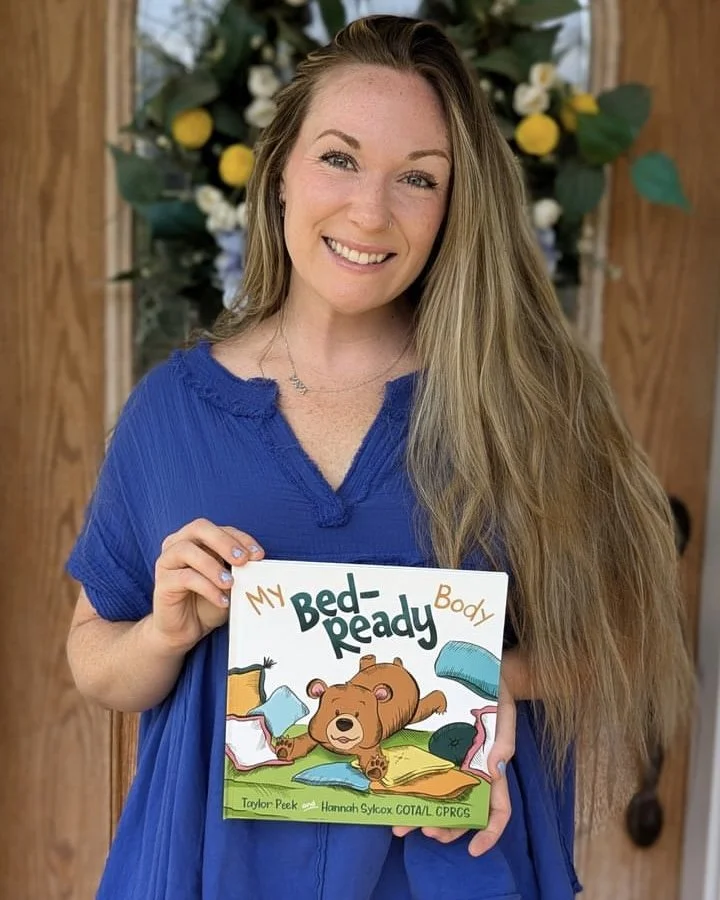6 Sensory Movements to Improve Your Child’s Sleep
The “bedtime struggle” is one of those universal truths that all parents deal with; right up there with your child’s superhuman ability to detect the very second you answer a phone call, or attempt to sneak into the bathroom to take care of business in peace.
After a long day, your child is overstimulated, craving connection, and visibly tired but just isn’t ready to settle down for sleep (no matter how much they may need it). Add in a child’s desire for control and you’ve got a recipe for a less-than-cuddly bedtime battle that can take your evening from sweet to struggle real quick.
We know why our children don’t want to go to bed. They don’t want to say “see-you-later” for the night. Their minds are dysregulated and unsettled. They have had to listen to others all day long and they know that sleep is something that only they can control.
So, we found a way to give your child exactly what they’re needing, all while eliminating the bedtime battle and preparing for a night of blissful sleep.
The answer? Connection, co-regulation, and sensory movements. This list of 6 movements offer both proprioceptive and vestibular input for your child (more on that later!). This basically means that their body has the opportunity to become calm and regulated, their mind organized, and they’re connecting with their caregivers in the process- a win/win for everyone.
The Rolling Wave
LINEAR SWINGING
Sit on the Floor: Have your child sit with their legs bent (knees to their chest) and wrap their arms around their legs.
Roll Backward: Encourage your child to roll backward onto their back and from their back to a seated position again.
Sit Up: Help your child to do this movement in one fluid motion. Repeat this sequence 5 to 10 times.
ALTERNATIVE FOR CHILDREN WHO MIGHT NOT BE ABLE TO DO IT INDEPENDENTLY:
Sit on the Floor: Parent, sit on the floor in the criss-cross applesauce position. Have your child sit on your lap.
Roll Backward: Wrap your arms around your child. Roll backward onto your back, then back up to the seated position in one fluid motion.
Sit up: Repeat this sequence 5 to 10 times.
The Swinging Sloth
SIDE-TO-SIDE SWINGING
Support your Child: Safely lift your child as they are facing you and allow them to wrap their legs around your waist. Alternatively, your child can lay on the ground and you can lift them by their ankles or calves.
Invert Gently: Slowly tilt your child backward until they are upside down, making sure their head is close to the ground but not touching.
Swing Side to Side: Gently sway your child from side to side about 5 to 10 times, mimicking the motion of a pendulum, while keeping movements slow and controlled.
The Rumbling Thunder
PLAY THE DRUMS ON THE CARPET
Sit Together: Sit on the floor with your child.
Drum with Hands: Start drumming with your hands on the floor, pretending to be thunder. Encourage the child to mimic your actions.
Add music: (optional) Play along or sing a simple tune while drumming, making it more engaging
The Leaping Frog
JUMP AND CRASH ONTO SOME CUSHIONS
Set Up Cushions: Arrange cushions or pillows on the floor in front of the couch to create a soft landing area.
Climb and Jump: Have your child climb onto the couch or bed, then jump off onto the cushions, ensuring they land safely.
Crash and Repeat: Encourage your child to enjoy the crash landing, then climb back up and repeat the jump.Repeat 5 to 10 times (Stop activity if you notice your child becoming too overstimulated.)
The Brave Caterpillar
ROLL THE CHILD IN A BLANKET COCOON
Lay Out a Blanket: Spread a blanket on the floor and have your child lie down at one end with their head sticking out of the blanket.
Roll Up Gently: Slowly roll your child up in the blanket, ensuring they feel snug but not too tight.
Unroll: Encourage your child to pretend they’re a caterpillar in their cocoon. After one minute or less, unroll your child and tell them they've become a beautiful butterfly.
The Whispering Wind
ORAL MOTOR INPUT
Pretend Feather: Parent, extend your hand and pretend it is a feather.
Blow Gently: Encourage your child to blow hard out of their mouth, imagining they are keeping the 'feather’ afloat.
Repeat Blowing: As your hand floats down. have the child blow again to make it rise, repeating the cycle 5 to 10 times.
This partial sequence of 6 movements comes from a full sequence of 13 sensory movements written into the interactive children’s book called My Bed-Ready Body.
The movements included in the book are laid out in a methodical sequence to allow your child to receive both proprioceptive and vestibular input. These inputs work to provide sensory integration and modulation, grounding sensation, deep pressure and calming effects within the body, allowing your child’s nervous system to regulate while their body prepares for sleep. (And, as a bonus, some parents have even noted better sleep as they’ve worked through the movements with their children!)
Written by Taylor Peek and Hannah Sylcox, COTA/L, CPRCS, My Bed-Ready Body has become a beloved staple in the bedtime routine of families across the United States as well as in several countries all over the world.
This book has received great feedback about how effective it has been in helping children sleep sooner, better, and longer, and how it has helped to resolve bedtime battles, not just for sensory-seeking children, but for all children (and their parents). My Bed-Ready Body has also become a useful tool in many OT offices as they’ve been able to share a solution to help families with bedtime struggles.
The book has an engaging storyline which allows your children to have fun as they act as animals or elements of nature, and all the while they have no idea that they’re actually giving their body everything it needs to prepare for better sleep.
You can learn more about My Bed-Ready Body at www.taylorpeekcreative.com. And while you’re there, be sure to grab a copy so that you, too, can be on your way to fun and connection before bed, and to a better-rested child.
—
Taylor Peek is an Austin-based author and illustrator of children’s books and mother of two littles. She had always found ways to put her creativity to use (even in her early career of veterinary management), but it wasn’t until having children of her own that the spark was ignited to create picture books.
Taylor is passionate about creating meaningful books that bring families together. With books like My Bed-Ready Body and its successor, My Calme Body, she aims to give families a means of connection while addressing (some of) the challenges that come with parenthood.
When she is not creating her own books, she works with other authors to bring their works to life through illustrations, editing, book design, logo creation, and more. You can learn more about her services at www.taylorpeekcreative.com.
She also documents and shares the process of writing, illustrating, and designing on her Instagram page @taylor.peek.creative and is happy to connect with the people who join her there!
—-
Hannah Sylcox is a mom of 3 and a passionate Certified Occupational Therapy Assistant (COTA/L) and Certified Primitive Reflex Clinical Specialist dedicated to supporting children’s growth and development. With years of experience and a deep understanding of sensory integration and motor development, Hannah creates engaging, educational, and practical content for parents, caregivers, educators, and therapists on her Instagram page @sensoryplay.allday.
Her expertise shines in her unique approach to teaching, offering DIY ideas, sensory strategies, and actionable tips that are both fun and effective. She is the co-creator of the interactive bedtime book, My Bed-Ready Body, which uses sensory strategies to help children prepare their bodies for sleep. She also designs printable resources and sensory tools to aid in emotional regulation.
Hannah’s work extends into helping children and families navigate everyday challenges. Her content reflects her love for play, exploration, and fostering connection between children and their caregivers.
